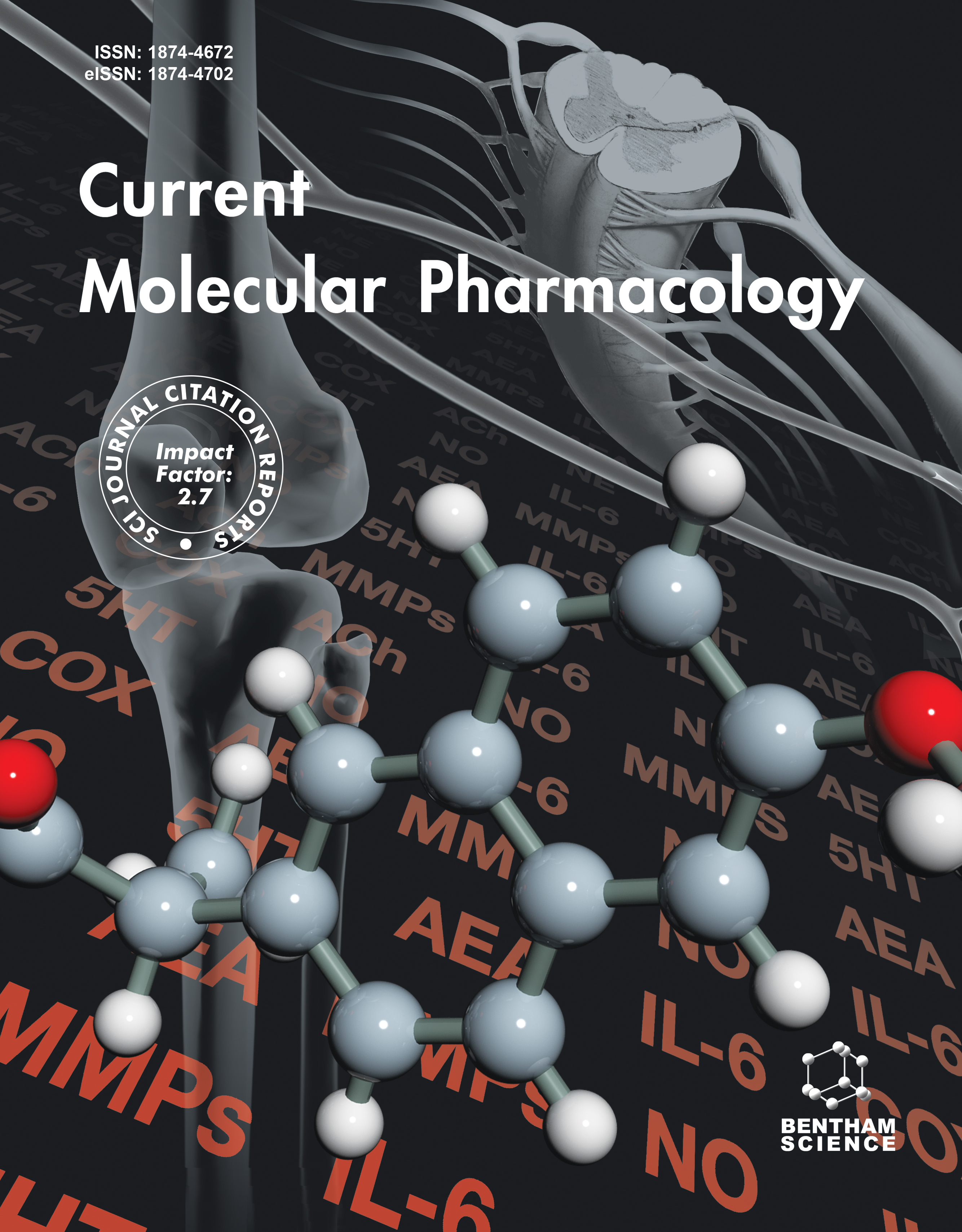- Home
- A-Z Publications
- Current Molecular Pharmacology
- Previous Issues
- Volume 16, Issue 8, 2023
Current Molecular Pharmacology - Volume 16, Issue 8, 2023
Volume 16, Issue 8, 2023
-
-
D-allose: Molecular Pathways and Therapeutic Capacity in Cancer
More LessBackground: Despite the implementation of various cancer therapies, adequate therapeutic efficacy has not been achieved. A growing number of studies have been dedicated to the discovery of new molecules to combat refractory cancer cells efficiently. Recently, the use of a rare type of sugar, D-allose, has attracted the attention of research communities. In combination with the first-line treatment of cancers, including di Read More
-
-
-
Role of SIRT-1 as a Target for Treatment and Prevention of Diabetic Nephropathy: A Review
More LessAuthors: Anita Kumari, Nalini Sodum, Velayutham Ravichandiran and Nitesh KumarType-2 diabetes mellitus is a prime factor for the development of Diabetic Nephropathy (DN) that affects the vital organ namely the kidneys, and further alters the functions of the nephron system. DN is nowadays becoming a challenge for scientists towards the world because of its high pervasiveness and complexity of medication. Various risk factors are involved in the initiation of pathogenic DN, which are associated wi Read More
-
-
-
PCSK9 Biomarker and Key Modulator for Cardiovascular Disorders: Heralding a New Therapeutic Era and Their Future Perspectives
More LessAuthors: Jitendra Gupta and Reena GuptaCardiovascular disorders (CVDs) are the leading cause of death worldwide and are accelerated via the low level of low-density lipoprotein-cholesterol (LDL-C). The proprotein convertase subtilis/kexin type9 (PCSK9), a vital regulator and a biomarker, circulates for the LDL-C and has the degradation capability of the low-density lipoprotein receptor (LDLR). PCSK9 has modulated the overall mechanism by transcription, sec Read More
-
-
-
Anti-angiogenic Drug Resistance: Roles and Targeting of Non-coding RNAs (microRNAs and long non-coding RNAs)
More LessAuthors: Masoumeh E. Dashtaki and Sorayya GhasemiCancers with a high capability for angiogenesis are frequently regarded as being difficult to treat. Anti-angiogenesis drugs are considered the primary therapy for these types of cancers. Due to intrinsic or acquired anti-angiogenesis resistance, therapies result in moderate clinical consequences, despite some hopeful findings. The importance of non-coding RNAs (ncRNAs) such as microRNAs (miRNAs), long non-cod Read More
-
-
-
Guggulsterone Promotes Nasopharyngeal Carcinoma Cells Exosomal Circfip1L1 to Mediate miR-125a-5p/VEGFA Affecting Tumor Angiogenesis
More LessAuthors: Ting Zhou, Shunli Zhao, Sanyuan Tang, Yongli Wang, Ruoxia Wu, Xiaoyan Zeng, Ping Yang, Xi Zhang and Xuefei TianBackground: Nasopharyngeal carcinoma (NPC) is a usual head and neck malignancy. Guggulsterone (GS) has potential in cancer chemoprophylaxis and treatment, but its therapeutic effect on NPC is unknown. We aimed to explore whether GS could promote the secretion of exosomal circFIP1L1 from NPC cells and its regulatory mechanism. Methods: NPC tissues and adjacent tissues were collected from NPC patients. Human naso Read More
-
-
-
IDO2-siRNA Carried by Salmonella Combined with Nifuroxazide Attenuates Melanoma Growth
More LessBackground: Melanoma, a highly malignant skin cancer, is a hot topic in oncology treatment research. Nowadays, tumor immunotherapy, especially immunotherapy combined with other therapies, has attracted more and more attention. Indoleamine 2,3-dioxygenase 2 (IDO2), a ratelimiting enzyme of the tryptophan metabolism pathway in the urine of dogs with immunosuppression, is highly expressed in melano Read More
-
-
-
BBOX1-AS1 Activates Hedgehog Signaling Pathway to Facilitate the Proliferation and Stemness of Esophageal Squamous Cell Carcinoma Cells via miR-506-5p/EIF5A/PTCH1 Axis
More LessAuthors: Liya Hu, Hong Cao, Lijun Zheng and Ruichao LiAims and Objective: This study aimed to unveil the specific function of lncRNA BBOX1 antisense RNA 1 (BBOX1-AS1) in ESCC cells and the underlying regulatory mechanism. Background: Esophageal squamous cell carcinoma (ESCC) is a deadly disease. Molecular mechanisms essential to ESCC development and progression require in-depth investigation. Long noncoding RNAs (lncRNAs) have been suggested as crucial ef Read More
-
-
-
Renoprotective Effect of Thymoquinone against Streptozotocin-Induced Diabetic Nephropathy: Role of NOX2 and Nrf2 Signals
More LessAuthors: Amal Hofni, Fares E.M. Ali, Ahmed R. N. Ibrahim and Esam M. AboubakerObjective: Diabetic nephropathy is an unavoidable complication of chronic uncontrolled diabetes mellitus. The pathogenesis of diabetic nephropathy is multifactorial, and the development of an effective therapy remains to be elucidated. The aim of the present study was to assess the role of NOX2 and Nrf2 in the protective mechanism of thymoquinone (THQ) against streptozotocin (STZ)-induced diabetic nephropat Read More
-
-
-
Restoration of Altered Oncogenic and Tumor Suppressor microRNA Expression in Breast Cancer and Colorectal Cancer Cell using Epicatechin
More LessBackground: MicroRNAs (miRNA) are small non-coding RNAs that regulate the function of mRNA post-transcriptionally in a tissue-specific manner. miRNA expressions are heavily dysregulated in human cancer cells through various mechanisms, including epigenetic changes, karyotype abnormalities, and miRNA biogenesis defects. miRNAs may act as either oncogenes or tumor suppressors under different conditions. Epi Read More
-
Most Read This Month
Article
content/journals/cmp
Journal
10
5
false
en


